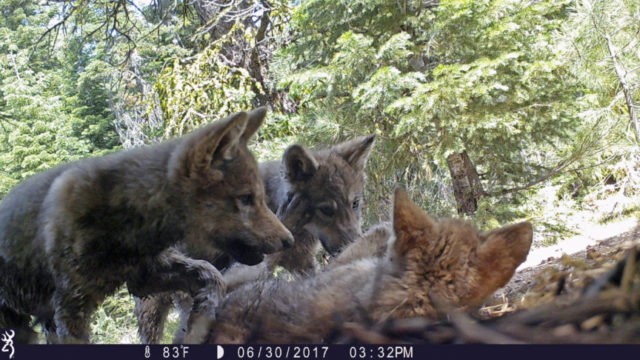BILLINGS, Mont. (AP) — U.S. wildlife officials plan to lift protections for gray wolves across the Lower 48 states, re-igniting the legal battle over a predator that’s run into conflicts with farmers and ranchers after rebounding in some regions, an official told The Associated Press.
Acting Interior Secretary David Bernhardt announced the proposal during a Wednesday speech at the North American Wildlife and Natural Resources Conference in Denver, a weeklong conservation forum for researchers, government officials and others, U.S. Fish and Wildlife Spokesman Gavin Shire said in an interview with the AP.
The decision was based on gray wolves successfully recovering from widespread extermination last century, Shire said. Further details were expected during a formal announcement planned in coming days.
Wildlife advocates reacted with outrage and promised to challenge in court any attempt to lift protections. Agriculture groups and lawmakers from Western states are likely to support the administration’s proposal.
Long despised by farmers and ranchers, wolves were shot, trapped and poisoned out of existence in most of the U.S. by the mid-20th century.
They received endangered species protections in 1975, when there were about 1,000 left, only in northern Minnesota. Now more than 5,000 of the animals live in the contiguous U.S.
Most are in the Western Great Lakes and Northern Rockies regions. Protections for the Northern Rockies population were lifted in 2011 and hundreds of wolves are killed annually by hunters in Wyoming, Idaho and Montana.
State officials and government biologists have said wolves continue to thrive despite pressure from hunting. The animals are prolific breeders and can adapt to a variety of habitats.
But wildlife advocates have fought to keep federal protections kept in place until wolves repopulate more of their historic range that stretched across most of North America.
Since being reintroduced in Yellowstone National park and central Idaho in the mid-1990s, the Northern Rockies population has expanded to parts of Oregon, Washington and California.
The Fish and Wildlife Service has argued for years that gray wolves have recovered in the lower 48 states, despite experts who contend they occupy about 15 percent of the territory they once roamed. Agency officials insist that recovery of wolves everywhere is not required for the species no longer to be in danger of extinction.
John Vucetich, a wildlife biologist at Michigan Technological University, said most wolf experts probably would agree the species is not at imminent risk, but he said he considers dropping federal protections as a premature move.
He said he could not pinpoint a threshold at which he would consider the wolves to be recovered but that “it’s nowhere near as small as 15 percent” of the far-flung regions where they once lived.
Many people “still find it difficult to live with wolves,” primarily because they kill livestock as well as deer and elk that people like to hunt, Vucetich said. If wolves are returned to state management, he said, “I do worry that some of the states could be overly aggressive and that wolves could fare worse than their current condition.”
The government first proposed revoking the wolf’s protected status across the Lower 48 states in 2013, but backed off after federal courts struck down its plan for “delisting” the species in the western Great Lakes region states of Michigan, Minnesota and Wisconsin.
Fish and Wildlife Service officials disclosed to the AP last year that another scientific review of the animal’s status had been launched.
Shire declined to disclose the agency’s rationale for determining the species had recovered, but said members of the public would have a chance to comment before a final decision in coming months.
“Recovery of the gray wolf under the Endangered Species Act is one of our nation’s great conservation successes, with the wolf joining other cherished species, such as the bald eagle, that have been brought back from the brink,” Shire later added in an emailed statement.
Jamie Clark, a former director of the Fish and Wildlife Service now with the Defenders of Wildlife group, said endangered species protections were need to prevent “an all-out war on wolves” in states that would allow hunting.
“We don’t have any confidence that wolves will be managed like other wildlife,” she said. “We’re going to fight this in any way possible.”
Ryan Yates, director of congressional relations for the American Farm Bureau Federation, applauded the federal agency’s plan and said many farmers and ranchers have lost livestock to wolf kills since the species was granted legal protections. The farmers and ranchers will respect state regulations aimed at managing wolf populations, he said.
“Some people like them, some people don’t, but the law’s the law,” Yates said.
Lawmakers in Congress frustrated with court rulings maintaining protections for wolves have backed legislation to forcibly strip protections in the Great Lakes region and beyond. A similar effort by lawmakers succeeded in 2011 for Northern Rockies wolves.
___
Flesher reported from Traverse City, Michigan.

COMMENTS
Please let us know if you're having issues with commenting.